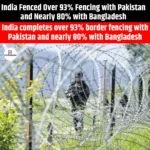The APEC Summit 2025
|
General Studies Paper II: Important International Institutions, Effect Of Policies & Politics Of World On India’S Interests |
Why (The APEC Summit 2025) in News?
This year, US President Donald Trump will meet Chinese President Xi Jinping on the sidelines of the APEC Summit 2025, which will be held in South Korea. It will be the first direct meeting between the two leaders during Trump’s second term.
- The annual meeting (The APEC Summit 2025) of the Asia-Pacific Economic Cooperation (APEC) Summit 2025 will be held in South Korea from October 31 to November 1, 2025.
- The event will be held in the Gyeongju Hwabaek International Convention Center. South Korea will host the summit for the second time after the 2005 event.
What is the Asia Pacific Economic Cooperation (APEC)?
- About: The Asia Pacific Economic Cooperation (APEC) is a regional platform and an inter-governmental forum that was created to foster economic cooperation and free trade in the Asia Pacific region. It was formally founded in 1989 when the first ministerial-level meeting took place in Canberra, Australia. The idea came at a time when the global economy was experiencing rapid changes due to globalization and regional integration.
- Objectives: The main objectives of APEC (The APEC Summit 2025) focus on the idea of sustainable and inclusive growth.
-
-
- APEC works to reduce barriers such as tariffs and complex regulations that affect cross-border exchange.
- The long-term vision of this group is to build a free and open trading system in the Asia Pacific.
- APEC supports policies that bring economies closer in technology, energy, digital economy, and people-to-people links.
- The forum emphasizes balance between economic progress and environmental protection. Climate change, clean energy, and green technologies are now part of the agenda.
- APEC also encourages collaboration in food security, health, digital safety, and disaster risk management.
-
- Member Countries: APEC currently has 21 member economies. Membership is defined by the principle of economic integration in the Pacific Rim. Members are often called “economies“.
-
-
- The members include: Australia, Brunei, Canada, Chile, China, Hong Kong, Indonesia, Japan, South Korea, Malaysia, Mexico, New Zealand, Papua New Guinea, Peru, Philippines, Russia, Singapore, Chinese Taipei, Thailand, Vietnam and the United States.
-
- History: The idea of a regional cooperation body in the Asia Pacific started in the 1980s. Australia and Japan took an early lead in proposing a forum where economies could meet and cooperate. The first APEC ministerial meeting was held in Canberra (1989), attended by 12 founding members: Australia, Brunei Darussalam, Canada, Indonesia, Japan, Korea, Malaysia, New Zealand, the Philippines, Singapore, Thailand, and the United States.
- Evolution: China, Hong Kong, and Chinese Taipei joined APEC in November 1991. Mexico and Papua New Guinea joined in 1993, Chile in 1994, and Peru, Russia, and Vietnam in 1998. (The APEC Summit 2025)
-
-
- 1994: The Bogor Goals were adopted in Bogor, Indonesia. These goals set a target for free and open trade and investment by 2010 for developed members and 2020 for developing members.
- 1995–1999: APEC expanded its agenda beyond trade to include human security, gender equality, and environmental sustainability.
- 2000s: APEC began to integrate digital economy, connectivity, and counter-terrorism measures.
- 2020: Amid the COVID-19 pandemic, APEC leaders introduced the Putrajaya Vision 2040, which emphasizes resilience, innovation, and sustainability.
-
- Structure: The APEC Summit 2025
-
- APEC Economic Leaders’ Meeting: This is the highest decision-making body, where heads of government meet annually to provide direction.
- APEC Ministerial Meeting: Ministers from member economies meet every year to review progress and decide on policies.
- Senior Officials’ Meetings (SOMs): Senior officials coordinate working groups and prepare for ministerial and leaders’ meetings.
- Committees: Various committees focus on trade, investment, economic cooperation, and sustainable development.
- Working Groups: Technical experts work on specific areas such as energy, health, education, small and medium enterprises, and digital economy.
- Secretariat: The APEC Secretariat is based in Singapore, which provides administrative support and ensures smooth coordination.
- APEC Business Advisory Council (ABAC): It was established in 1995, which brings together private sector leaders who advise governments on trade and investment. It acts as a bridge between policymakers and businesses.
Significance of APEC: The APEC Summit 2025
- Free & Open Trade: APEC plays a central role in pushing forward the vision of free and open trade. The adoption of the Bogor Goals in 1994 set a target for developed members to achieve open trade. APEC succeeded in lowering average tariffs in the region from 17 percent in 1989 to around 5 percent in 2018. This reduction helped expand trade flows and made products more accessible across borders.
- Global Economy: APEC members represent nearly 62 percent of world GDP and close to half of global trade. This makes the forum one of the largest economic groupings in the world. The group also supports supply chain networks and digital trade, which are vital for global economic stability.
- Neutral Platform: APEC provides a neutral platform where leaders and policymakers can engage in dialogue. It is not based on binding treaties, which allows members to discuss sensitive issues more openly. Several bilateral and multilateral talks on energy security, health, and digital transformation have taken place on the sidelines of APEC summits.
- Inclusive Growth: APEC places strong emphasis on inclusive growth and sustainability. It encourages member economies to adopt policies that balance development with environmental care. APEC also supports small and medium enterprises, women entrepreneurs, and digital startups to ensure that growth benefits reach wider sections of society.
India and APEC: The APEC Summit 2025
- India has always shown deep interest in joining the Asia Pacific Economic Cooperation (APEC) as a full member. At present, India holds only an observer status in the grouping.
- India made its first formal request to join in 1991, the same year when the process of liberalisation began in the Indian economy. The request was supported by India’s geographic position and growing trade interaction with Asia Pacific economies.
- The APEC represents more than one-third of the global population, for India that aspires to become a $5 trillion economy, APEC (The APEC Summit 2025) membership could provide vital support.
- APEC membership also fits into India’s Act East Policy. India has already joined other regional bodies like the Shanghai Cooperation Organisation (SCO). Joining APEC would be a logical step to strengthen India’s economic and strategic engagement in East and Southeast Asia.
- Despite repeated efforts, India has not been able to secure full membership in APEC. The perception has been made that India follows protectionist policies and does not fully align with APEC’s guiding principle.
- APEC (The APEC Summit 2025) decided to stop admitting new members in 1997 to focus on strengthening internal cooperation. The freeze was supposed to end in 2012, but no major decision followed, leaving India’s application pending.
|
Also Read: 17th BRICS Summit 2025 |









